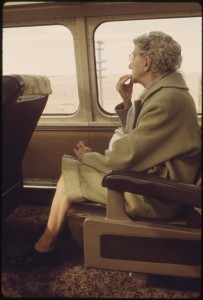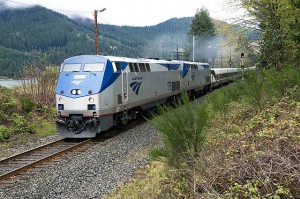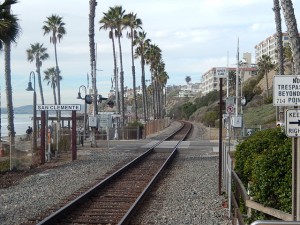If you’re interested in writing , and you’ve been on the internet in the last few days, you may have seen that Amtrak granted a pilot writers’ residency to a New York writer, who took the Lakeshore Limited to Chicago and back, working away in her 3’6” by 6’8” sleeper cabin. And since then, other writers have been weighing in, many with hopes of sign up for the next installment.
, and you’ve been on the internet in the last few days, you may have seen that Amtrak granted a pilot writers’ residency to a New York writer, who took the Lakeshore Limited to Chicago and back, working away in her 3’6” by 6’8” sleeper cabin. And since then, other writers have been weighing in, many with hopes of sign up for the next installment.
What follows is not an application, but an exploration: I’ve only ever been in coach, and if I got a free sleeper berth, I’d want to take my kids. (Or just sleep, uninterrupted.) But I’m fascinated by what makes trains so great for writing. Nearly everywhere I’ve lived has been on an Amtrak line, and every time I’ve traveled by train, I’ve gotten some good work done, whether on the page or just in my mind.
Writers who have been talking about trains this week in various places say much of the same things that I’ve experienced: the freedom from distractions, the delightful heightened blurriness that can come from hours looking out the window, the discrete amount of time, bounded by departure and arrival; the soothing, dreamy motion of the train. JK Rowling first imagined Harry Potter while on a crowded train; some New York writers report boarding trains just to write. For some, the train also provides a connection to childhood and memory, with newfound freedom, with people lost to the past.
 This mental spaciousness might come from the different relationship to time that comes once on-board. Even though we’re all trying to get more done with less time, it may be possible that people are starting to consider extended travel time as a gift, rather than a burden. A writer who took Amtrak one-way to a writing residency settled into the train’s slower pace. Two weeks later, her impatience flared as she waited for people to get off her return plane—and remembered that she’d been surrounded by the ease of those exchanging email addresses and sightseeing tips as they’d stepped off the train in Chicago.
This mental spaciousness might come from the different relationship to time that comes once on-board. Even though we’re all trying to get more done with less time, it may be possible that people are starting to consider extended travel time as a gift, rather than a burden. A writer who took Amtrak one-way to a writing residency settled into the train’s slower pace. Two weeks later, her impatience flared as she waited for people to get off her return plane—and remembered that she’d been surrounded by the ease of those exchanging email addresses and sightseeing tips as they’d stepped off the train in Chicago.
Time on the train can sometimes be the gift that won’t stop giving. In 2012, only about 70 percent of Amtrak’s long-haul trains ran on time; trips under 400 miles fare better. But this is par for the course for many train riders; many frequent riders, including me, on the Coast Starlight, consider running an hour or so late perfectly reasonable.
A recent trip south involved a five-hour delay; even though there were plenty of people calling their rides to change their plans, I didn’t hear any of the complaining to the conductors that you would have found at an airport ticket counter. We were going to get there when we got there.
Which means more time to look out the window. Even though many of the trains travel right near the highways a traveler would otherwise take, the view is so different. In the hour or so heading southbound from the San Francisco Bay Area, from a car, the main sights are fast food signs and billboards and noise barriers. But through the windows of the Coast Starlight, laundry hangs in people’s backyards; kids play in a makeshift pool; angry and clever graffiti covers walls and bridges. Trucks move pallets of paper. There’s the 49ers’ training camp. There are the salt flats. If you’re running six hours behind schedule, heading south out of Klamath Falls, you might just catch a view of Mount Shasta lit by sunrise.
 I’ve read about how taking new routes to places can spark creativity—my very unscientific opinion is that the train gives you the chance to really take in this new journey, both within and without. Traveling overnight in the leaned-back coach chairs, you see people heading off to brush their teeth. You know who brought their slippers. You know who gets quietly drunk before nodding off. You hope that the conductor moves the person who gets animatedly drunk to the sightseeing car. You hear the life story of the woman sitting across the aisle; you hear two teenagers behind you sorting out whether their life stories could possibly intersect, if just for tonight.
I’ve read about how taking new routes to places can spark creativity—my very unscientific opinion is that the train gives you the chance to really take in this new journey, both within and without. Traveling overnight in the leaned-back coach chairs, you see people heading off to brush their teeth. You know who brought their slippers. You know who gets quietly drunk before nodding off. You hope that the conductor moves the person who gets animatedly drunk to the sightseeing car. You hear the life story of the woman sitting across the aisle; you hear two teenagers behind you sorting out whether their life stories could possibly intersect, if just for tonight.
On my most recent trip, we stopped for an unexplained hour somewhere outside of King City, in the Salinas Valley. It was growing dark, and between two dilapidated buildings, there was a flicker of movement. A man gathered up pieces of what looked like trash. He shaped it into a pile and lit it on fire, a fire that seemed to lick up the sides of the walls.
For a moment, I wondered if I should call the conductor. Was he trying to burn everything down? Was this why we had stopped? But then, the fire hunkered lower, and the man did, too, warming his palms over the flames. I turned off my reading light and leaned my head against the window.
I watched until it grew so dark that the only things that seemed to exist were the fire and the man’s illuminated hands. And then, with a jolt, the train started up and we pulled away.
**
Images from the U.S. National Archives, the Oregon Department of Transportation, and Billy Hathorn, all via Wikimedia Commons.
Lovely.
That’s wonderful. I love taking the train, it’s such a civilized way to travel.
Loved this, Cameron.
Brings back memories of feverishly scribbling (dreadful) poems in notebooks aboard gloriously dirty Italian trains, watching the Roman pines blur by out of the corner of my eye.
I’d take trains everywhere if I could.
Thank you so much!
Trains are the best place I’ve ever found to write. And they’re the thing I miss most about living in Europe. When I lived in Switzerland trains were my method of transportation, and something about their mesmerizing motion always provoked the most satisfying insights.
I’m so happy to discover that I’m not alone in considering the window seat of a train as the ideal writing space.